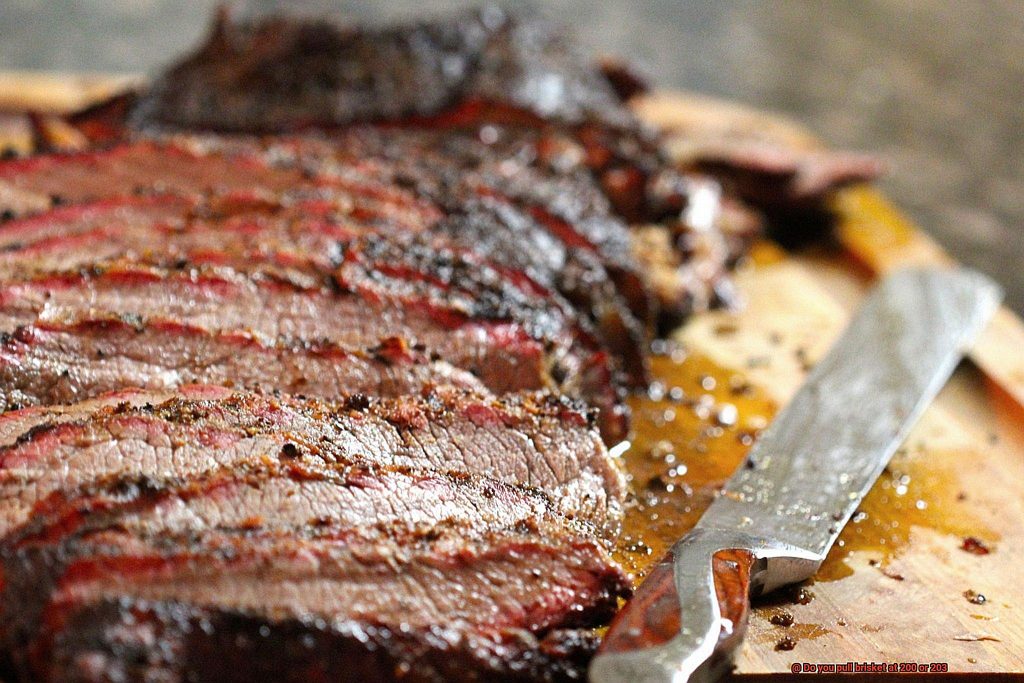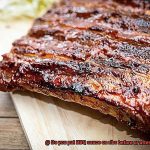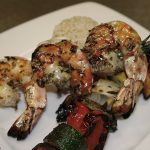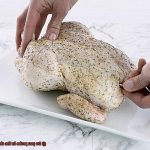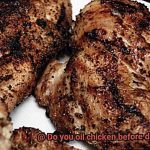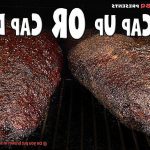Are you a BBQ fanatic looking to perfect your brisket game? Then you’ve likely heard the age-old question: do you pull brisket at 200 or 203 degrees Fahrenheit? The answer might seem trivial, but it’s a topic that has sparked heated debates among barbecuers for years.
Some swear by the magic number of 200°F, while others adamantly argue that 203°F is the only way to go. But what’s the real difference between these two temperatures, and how does it affect the taste and texture of your beloved brisket?
In this blog post, we’ll explore everything you need to know about pulling brisket at 200 or 203°F. We’ll dive deep into the science behind collagen breakdown and texture, examine common arguments for both temperatures, and even share some tips and tricks for achieving perfection no matter which side of the debate you fall on.
But it’s not just about temperature – cooking time and equipment also play a crucial role in achieving that melt-in-your-mouth texture and rich smoky flavor. Whether you’re a seasoned pitmaster or a backyard BBQ enthusiast, understanding the nuances of pulling brisket is key to taking your BBQ game to the next level.
So grab yourself a cold drink, sit back, and join us as we settle one of BBQ’s most hotly debated topics once and for all.
Contents
The Benefits of Cooking Brisket
Brisket, a tough cut of meat, may seem daunting to cook, but the benefits are well worth the effort. Not only is it affordable compared to other beef cuts, but it is also versatile and can be prepared in many different ways. Here are some of the benefits of cooking brisket:
- Affordability: Brisket is a budget-friendly option that can feed a crowd or provide meals for the week without breaking the bank.
- Versatility: Brisket can be smoked, braised, roasted, or grilled, and each method produces a unique flavor profile, texture, and tenderness. You can experiment with different cooking techniques to find the perfect recipe for your taste.
- Flavor: Brisket is known for its rich and savory flavor profile, making it a favorite among meat lovers. You can enhance the taste even more by trying different rubs, marinades, and sauces. Some popular seasonings include salt, pepper, garlic powder, onion powder, paprika, and chili powder.
- Rewarding: Cooking brisket requires patience and attention to detail. This low and slow cooking method can be challenging but also incredibly rewarding when you achieve a perfectly cooked brisket. Mastering the art of cooking brisket is something to be proud of and will impress your friends and family for years to come.
What is the “Stall” in Brisket Cooking?
You’ve come face to face with the infamous “Stall” in brisket cooking. As an expert, let me take you on a journey through this fascinating phenomenon and equip you with tips to overcome it.
The Stall typically occurs when the internal temperature of the brisket hits around 150°F (65°C). The heat from the smoker or grill evaporates moisture from the meat’s surface, which cools it down and slows down the cooking process. This evaporation creates a cooling effect similar to how sweat cools down our bodies.
During the Stall, it is common for the internal temperature of the brisket to plateau or even decrease slightly despite continued cooking. This can be alarming for novice cooks who may not be familiar with this phenomenon. However, it’s entirely normal and expected.
To conquer the Stall, many pitmasters choose to wrap their brisket in foil or butcher paper. This technique traps in moisture and heat, creating a mini-oven that encourages the brisket to continue cooking. Butchers paper is preferred by some as it creates a better bark while still allowing some evaporation. On the other hand, some pitmasters prefer not to wrap their brisket at all, believing that it can lead to a loss of flavor and texture.
What is the Ideal Temperature for Pulling Brisket?
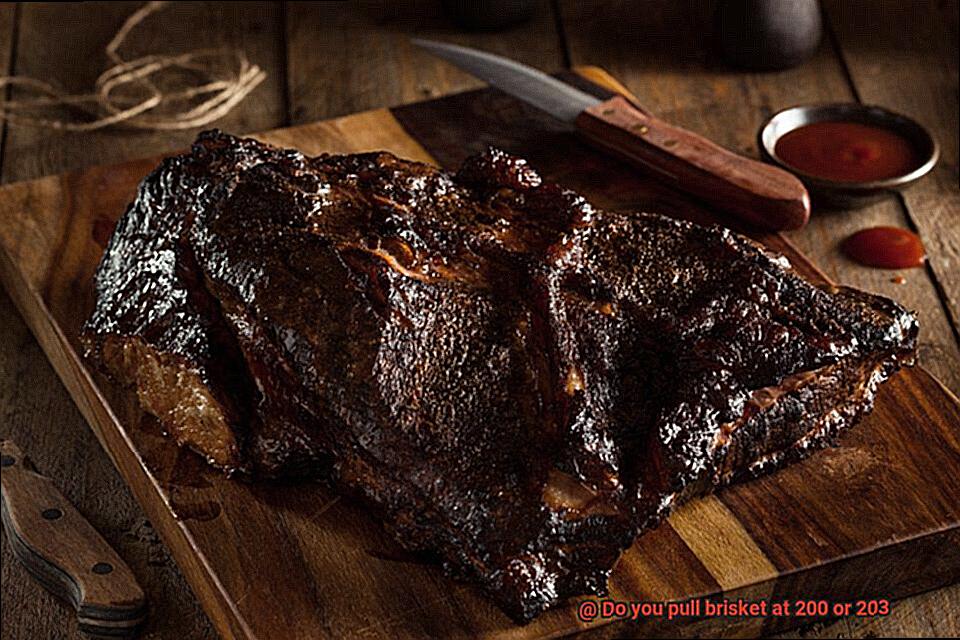
I am here to guide you through the science behind achieving the ideal temperature for pulling brisket.
Firstly, let’s establish the optimal temperature range. While personal preference and cooking methods may vary, most experts agree that the ideal temperature for pulling brisket falls between 195-205 degrees Fahrenheit. At this temperature range, the connective tissue in the meat has sufficiently broken down, resulting in a succulent texture that practically melts in your mouth.
However, it’s essential to measure the temperature at the thickest point of the brisket, ensuring that the entire cut of meat has reached the proper temperature for optimal tenderness. Neglecting to do so could result in unevenly cooked meat and an unsatisfactory final product.
Furthermore, be aware of common mistakes that can ruin your pulled brisket. Cooking at too low a temperature can leave you with tough and chewy meat that’s difficult to shred. Conversely, cooking at too high a temperature can cause your brisket to dry out or become mushy. Therefore, it’s crucial to keep an eye on your thermometer and aim for that sweet spot between 195-205 degrees Fahrenheit.
Once you’ve achieved the optimal temperature for pulling brisket, don’t rush to serve it immediately. Allow it to rest for at least 30 minutes before pulling, giving time for the juices to redistribute throughout the meat and enhancing its flavor and moisture.
Pros and Cons of Pulling at 200 Degrees Fahrenheit
One of the crucial steps in making the perfect brisket is pulling it at the right temperature. The great debate among BBQ enthusiasts is whether to pull at 200 or 203 degrees Fahrenheit. As a seasoned expert, let’s delve into the pros and cons of pulling at 200 degrees Fahrenheit.
Firstly, let’s explore the benefits of pulling at 200 degrees Fahrenheit. One of the most significant advantages is that it results in a more tender and succulent brisket. The connective tissue breaks down more slowly at lower temperatures, retaining moisture in the meat, making for a juicy, melt-in-your-mouth experience. Additionally, pulling at 200 degrees Fahrenheit enhances the smoky flavor of your brisket since it has more exposure to smoke for a longer time. Finally, pulling at a lower temperature minimizes the risk of overcooking and producing a dry and tough brisket.
However, there are potential downsides to consider when pulling at 200 degrees Fahrenheit. Firstly, the meat may be too tough and challenging to slice if it hasn’t been cooked long enough. Secondly, pulling at a lower temperature may result in a less flavorful bark on your brisket since it has had less time to form while cooking. Lastly, some experts argue that pulling at 200 degrees Fahrenheit may not be safe since it does not fully kill any potential bacteria in the meat.
In conclusion, determining the perfect temperature to pull your brisket comes down to personal preference and experience with your equipment and cooking methods. If you prefer a tender and juicy brisket with a stronger smoky flavor, then pulling at 200 degrees Fahrenheit is an excellent option for you. However, suppose you prioritize a flavorful bark and ensuring that any potential bacteria are fully eliminated. In that case, pulling at 203 degrees Fahrenheit is worth considering.
Pros and Cons of Pulling at 203 Degrees Fahrenheit
Today, we’re tackling one of the most debated topics in the world of brisket – pulling at 203 degrees Fahrenheit. Some argue that the difference between this temperature and the classic 200 degrees Fahrenheit is negligible, but let’s dig deeper into the pros and cons.
Firstly, pulling brisket at 203 degrees Fahrenheit can lead to a more tender and juicy end product. The higher temperature allows for more collagen to break down, resulting in softer meat. Additionally, the extra time spent cooking at this temperature can result in a richer and more complex taste. Who doesn’t want their brisket packed with flavor?
However, before you fire up your grill, there are some potential drawbacks to consider. Pulling at 203 degrees Fahrenheit can be more challenging to achieve consistent results. The higher temperature may cause more variability in how the meat cooks, leading to uneven results. Additionally, if not watched closely, the meat may become overly dry or tough.
It’s important to note that pulling at 203 degrees Fahrenheit requires more patience and attention compared to pulling at 200 degrees Fahrenheit. The extra cooking time means it takes longer to reach the desired internal temperature, and it may also require more monitoring to prevent overcooking or drying out.
So how do you decide which temperature to pull your brisket? Consider personal preference and individual circumstances. Weigh the benefits of pulling at 203 degrees Fahrenheit against potential drawbacks and take into account factors such as cooking time and consistency.
Tips for Achieving Perfectly Cooked Brisket Every Time
Cooking brisket can be a challenging task, but it’s worth the effort when you achieve that perfectly tender and juicy result. Here are some tips and techniques to help you cook a delicious brisket every time.
Temperature Matters
The debate between pulling brisket at 200 or 203 degrees Fahrenheit is a common one among pitmasters and BBQ enthusiasts. While both temperatures can produce a tasty brisket, the decision ultimately depends on personal preference.
If you prefer a firmer, sliceable brisket, pull it at 203 degrees Fahrenheit. Pulling at 200 degrees Fahrenheit results in a more fall-apart tender texture that is perfect for shredding or pulling apart.
Invest in a Meat Thermometer
To accurately track the internal temperature of the meat, invest in a high-quality meat thermometer. Insert the thermometer into the thickest part of the brisket without touching any bones to get an accurate reading.
Cook Low and Slow
Brisket requires low and slow cooking to break down its collagen and connective tissue. Aim for a consistent temperature of around 225-250 degrees Fahrenheit for several hours. Periodically check on the brisket and spritz it with liquid (such as apple juice or vinegar) to prevent it from drying out.
Let It Rest
After removing the brisket from the heat source, let it rest for at least 30 minutes to allow the juices to redistribute throughout the meat. This results in a more tender and flavorful end product.
Experiment with Rubs and Seasonings
Adding rubs and seasonings can add depth and complexity to the flavor profile of the brisket. Try different spices and herbs to find your favorite combination.
Choose High-Quality Meat
Look for brisket with good marbling and consistent thickness throughout. This will ensure that you’re starting with a quality cut of meat.
Common Mistakes to Avoid When Cooking Brisket
Cooking it can be intimidating, even for experienced grillers. To ensure that your brisket turns out perfectly every time, it’s important to avoid these common mistakes.
Firstly, make sure to give the meat enough time to rest after cooking. This is crucial as it allows the juices to redistribute throughout the meat, resulting in a tender and juicy brisket. Don’t rush the process; let it rest for at least 30 minutes before slicing.
Secondly, proper fat trimming is essential. A thick layer of fat on top needs to be trimmed down to about ¼ inch before cooking. Failing to do so can result in a tough and chewy brisket, which nobody wants.
Thirdly, using a meat thermometer is a must. The internal temperature of the brisket is crucial when determining if it’s ready to be pulled from the grill. Make sure to insert a meat thermometer into the thickest part of the meat, and ensure that the temperature reaches between 200-203 degrees Fahrenheit before pulling it from the grill.
Fourthly, cooking at the right temperature is paramount. Brisket needs to be cooked low and slow, typically between 225-250 degrees Fahrenheit. Cooking at too high of a temperature can result in a dry and tough brisket, while cooking at too low of a temperature can result in an undercooked and tough brisket.
Lastly, don’t forget to wrap the brisket during the cooking process. Wrapping it in foil or butcher paper helps to trap in moisture and flavor, resulting in a tender and juicy brisket.
To summarize:
- Give the meat enough time to rest.
- Trim the fat properly.
- Use a meat thermometer.
- Cook at the right temperature.
- Wrap the brisket during cooking.
8OiaypcnXDk” >
Conclusion
As any seasoned barbecuer knows, the decision to pull brisket at 200 or 203 degrees Fahrenheit is a hotly debated topic. While both temperatures can result in a delicious brisket, the ultimate choice depends on your personal preference and familiarity with your cooking equipment.
For those who prefer a firmer texture that lends itself to slicing, pulling at 203 degrees Fahrenheit is the way to go. On the other hand, pulling at 200 degrees Fahrenheit produces fall-apart tender meat that’s perfect for shredding or pulling apart.
To ensure perfectly cooked brisket every time, invest in a reliable meat thermometer to keep track of the internal temperature. Cook low and slow at around 225-250 degrees Fahrenheit for several hours, spritzing with liquid periodically to prevent drying out. Once removed from heat, let it rest for at least half an hour so that the juices can redistribute throughout the meat.
Avoid common mistakes such as improper fat trimming, not using a thermometer, cooking at too high or low of a temperature, forgetting to wrap during cooking and not giving enough time for resting.
Cooking brisket may seem intimidating but mastering how to pull it is essential in elevating your BBQ game.

